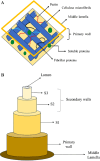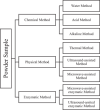Exploring Plant Agro-Industrial By-Products as a Source of Fibrous Food Ingredients: A Review of Extraction Methods and Technological Properties
- PMID: 40650498
- PMCID: PMC12254927
- DOI: 10.1111/1750-3841.70408
Exploring Plant Agro-Industrial By-Products as a Source of Fibrous Food Ingredients: A Review of Extraction Methods and Technological Properties
Abstract
The agro-industrial sector generates a large amount of by-products, and researchers have been seeking new ways to use them, especially those of plant origin. The concept of biorefinery and circular bioeconomy aims to enhance and maximize the use of organic ingredients, emphasizing the use of renewable and sustainable materials. Many by-products are rich in both macro and micronutrients, making them attractive for reuse and the development of new products. Plant fibers, composed of sclerenchyma cells, are an important example and are classified according to their origin. The use of food processing by-products as a source of fiber has great potential to reduce waste and improve nutritional value. Industrial interest in plant fibers is growing, making them a viable alternative to traditional ingredients. These fibers, originating from agro-industrial by-products, have proven profitable for food enrichment. This review examines the current state of the art in recovering and applying fibrous by-products, highlighting methods for obtaining them, their technological properties, and potential future applications. Furthermore, the conditions for modifying agro-industrial waste are analyzed, and the importance of understanding the original fibrous matrix is emphasized to select the most suitable transformation process, thereby ensuring a high-quality final product.
Keywords: agro‐industrial by‐products; fibrous extraction; fibrous ingredients; plant‐based ingredients.
© 2025 The Author(s). Journal of Food Science published by Wiley Periodicals LLC on behalf of Institute of Food Technologists.
Conflict of interest statement
The authors declare that they have no conflicts of interest.
Figures





Similar articles
-
Management of urinary stones by experts in stone disease (ESD 2025).Arch Ital Urol Androl. 2025 Jun 30;97(2):14085. doi: 10.4081/aiua.2025.14085. Epub 2025 Jun 30. Arch Ital Urol Androl. 2025. PMID: 40583613 Review.
-
Enhancing Human Health Through Nutrient and Bioactive Compound Recovery from Agri-Food By-Products: A Decade of Progress.Nutrients. 2025 Jul 31;17(15):2528. doi: 10.3390/nu17152528. Nutrients. 2025. PMID: 40806112 Free PMC article. Review.
-
Potential of Plant-Based Oil Processing Wastes/By-Products as an Alternative Source of Bioactive Compounds in the Food Industry.Foods. 2025 Aug 2;14(15):2718. doi: 10.3390/foods14152718. Foods. 2025. PMID: 40807655 Free PMC article. Review.
-
Polyphenols in Foods and Their Use in the Food Industry: Enhancing the Quality and Nutritional Value of Functional Foods.Int J Mol Sci. 2025 Jun 17;26(12):5803. doi: 10.3390/ijms26125803. Int J Mol Sci. 2025. PMID: 40565272 Free PMC article. Review.
-
From Agro-Industrial Waste to Natural Hydrogels: A Sustainable Alternative to Reduce Water Use in Agriculture.Gels. 2025 Aug 7;11(8):616. doi: 10.3390/gels11080616. Gels. 2025. PMID: 40868747 Free PMC article. Review.
References
-
- Adetunji, L. R. , Adekunle A., Orsat V., and Raghavan V.. 2017. “Advances in the Pectin Production Process Using Novel Extraction Techniques: A Review.” Food Hydrocolloids 62: 239–250.
-
- Aguilera, J. M. 2025. “Food Matrices as Delivery Units of Nutrients in Processed Foods.” Journal of Food Science 90, no. 2: e70049. - PubMed
-
- Albersheim, P. , Darvill A., Roberts K., Sederoff R., and Staehelin A.. 2010. Plant Cell Walls. Garland Science.
-
- Ali, S. , Rani A., Dar M. A., et al. 2024. “Recent Advances in Characterization and Valorization of lignin and Its Value‐added Products: Challenges and Future Perspectives.” Biomass 4, no. 3: 947–977.
-
- Almoumen, A. , Mohamed H., Ayyash M., et al. 2024. “Harnessing Date Fruit Pomace: Extraction of High Fibre Dietary Ingredient and Its Impact on High Fibre Wheat Flour Dough.” NFS Journal 35: 100178.
Publication types
MeSH terms
Substances
Grants and funding
- Fundação de Amparo à Pesquisa do Estado de Goiás - FAPEG
- Conselho Nacional de Desenvolvimento Científico e Tecnológico - CNPq
- Coordenação de Aperfeiçoamento de Pessoal de Nível Superior - CAPES
- Instituto Federal de Educação, Ciência e Tecnologia Goiano - IFGoiano
- Financiadora de Estudos e Projetos - FINEP
LinkOut - more resources
Full Text Sources
Medical

